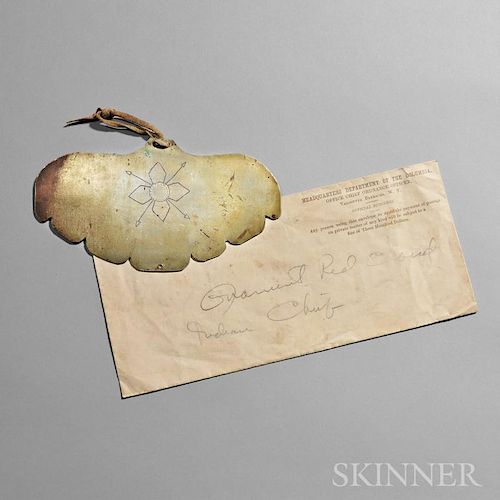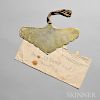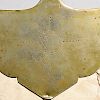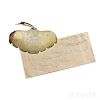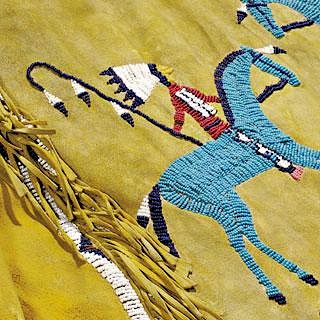Two Historic Lakota German Silver Pendants Owned by Famed Chiefs Red Cloud and Spotted Tail
Lot 190
About Seller
Bonhams Skinner
274 Cedar Hill Street
Marlborough, MA 01752
United States
Founded over four decades ago, Bonhams Skinner offers more than 60 auctions annually. Bonhams Skinner auctions reach an international audience and showcase the unique, rare, and beautiful in dozens of categories, including the fine and decorative arts, jewelry, modern design, musical instruments, sc...Read more
Categories
Estimate:
$20,000 - $30,000
Absentee vs Live bid
Two ways to bid:
- Leave a max absentee bid and the platform will bid on your behalf up to your maximum bid during the live auction.
- Bid live during the auction and your bids will be submitted real-time to the auctioneer.
Bid Increments
| Price | Bid Increment |
|---|---|
| $0 | $10 |
| $100 | $25 |
| $500 | $50 |
| $1,000 | $100 |
| $3,000 | $250 |
| $5,000 | $500 |
| $10,000 | $1,000 |
| $30,000 | $2,500 |
| $50,000 | $5,000 |
| $100,000 | $10,000 |
| $300,000 | $25,000 |
| $500,000 | $50,000 |
| $1,000,000 | $100,000 |
About Auction
By Bonhams Skinner
Mar 14, 2015 - Mar 15, 2015
Set Reminder
2015-03-14 10:00:00
2015-03-15 10:00:00
America/New_York
Bidsquare
Bidsquare : American Indian & Ethnographic Art
https://www.bidsquare.com/auctions/skinner/american-indian-ethnographic-art-489
Bonhams Skinner bidsquare@bonhamsskinner.com
Bonhams Skinner bidsquare@bonhamsskinner.com
- Lot Description
Two Historic Lakota German Silver Pendants Owned by Famed Chiefs Red Cloud and Spotted Tail, c. 1850s, the first cloud-shaped form with hide suspension, engraved on the front with four-petal and arrow design, the back with etched figure of a man wearing a similar pectoral, and ink inscription reads "Ornament Red Cloud," the accompanying envelope with pencil note, "Ornament Red Cloud Indian Chief," written by William Starring and stamped from his post at "Headquarters, Department of the Columbia, Vancouver Barracks, Washington Territory," lg. of pectoral 6 in.; the second pectoral with buffalo hide suspension loop, rocker engraved quatrefoil and spider web design, inscribed on the back, "Ornament of Spotted Tail Sioux Chief," with similar marked envelope from the Headquarters, Department of the Columbia, lg. 7 1/2 in.; both pectorals have a hole at bottom center for an additional suspension, and a patina that is consistent with a mid-19th century date.
Provenance: Both pendants collected by William Starring.
Note: According to previous research, these gorgets were probably given to William Starring in the fall of 1866 at Fort Laramie, where he is known to have been stationed at the time. Plains Indians did not prefer the trade silver gorgets found in eastern North America, but instead favored the variant shape called "Pectoral," adopted primarily by the Kiowa, Cheyenne, Teton Sioux, and Shoshone. They were made primarily of German silver, an alloy of nickel, zinc, and copper.
A true career military man, William was born in New York in 1841 to Sylvanus Seaman Starring and Adeline Starring. He had a brother, Frederick Augustus Starring, who became a brigadier general.
William moved to Illinois when young, but returned east to attend West Point from 1860 to 1865. He then entered service in the US Army, most of which was spent out in the western territories. The period Starring spent in Fort Laramie in 1866 is notable, as it is the first known occasion on which he would have been in the vicinity of Red Cloud and Spotted Tail.
Access to the Powder River Basin was an issue in the late spring of 1866. Negotiations were underway for a treaty at Fort Laramie, which was attended by war chiefs Red Cloud, Standing Elk, Spotted Tail, Dull Knife and other leaders. During the negotiations, a few hundred troops under Col. Henry Carrington arrived at Fort Laramie to build forts along the Bozeman Trail. The arrival of Col. Carrington's troops meant that the negotiations underway were useless for the Sioux leaders, and that the Bozeman Trail would be opened without agreement of the chiefs. This became the spark that led to Red Cloud's War, as well as the defeat at Fort Kearny, Wyoming, in December of 1866 of the eighty men under the command of Lieut. Col. William Fetterman.
This also happened to be the same month that Starring and J.K. Hyer published their Sioux dictionary at Fort Laramie, an invaluable tool needed to communicate with the native leaders.
The documents related to Starring do not say when he might have received the two pectorals, although his knowledge of the Lakota language might mean that he was present at the treaty negotiations, both in the early spring or fall of 1866, and may have received the pieces at that time.
Additional history available at preview.
Estimate $20,000-30,000
The absence of a condition statement does not imply that the lot is in perfect condition or completely free from wear and tear, imperfections or the effects of aging. Condition requests can be obtained via email (lot inquiry button) or by telephone to the appropriate gallery location (Boston/617.350.5400 or Marlborough/508.970.3000). Any condition statement given, as a courtesy to a client, is only an opinion and should not be treated as a statement of fact. Skinner Inc. shall have no responsibility for any error or omission. - Shipping Info
-
Please visit http://www.skinnerinc.com/services/payment-and-shipping/ for information regarding the collection of items purchased at auction.
-
- Buyer's Premium



 EUR
EUR CAD
CAD AUD
AUD GBP
GBP MXN
MXN HKD
HKD CNY
CNY MYR
MYR SEK
SEK SGD
SGD CHF
CHF THB
THB